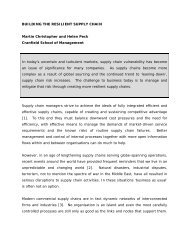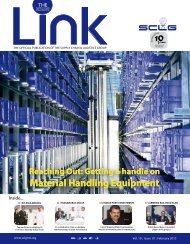You also want an ePaper? Increase the reach of your titles
YUMPU automatically turns print PDFs into web optimized ePapers that Google loves.
Information Technology 49<br />
be improved; the logistics and<br />
transportation industry will have<br />
better management of truck yards,<br />
container yards, shipping yards and<br />
cross-docking activity; consumer<br />
packaged goods will have easier<br />
receiving reconciliation, better lot<br />
tracking, faster and less expensive<br />
product recall and all the benefits<br />
associated with improved visibility<br />
throughout the supply chain.<br />
RFID is best viewed as part of a<br />
broader spectrum of sensor-based<br />
technologies. This includes the nowfamiliar<br />
technologies of barcode and<br />
magnetic stripe, as well as integration<br />
with equipment such as scales and<br />
dimensioning devices and sensors for<br />
such things as temperature, position<br />
and moisture. Hybrid sensors that<br />
combine RFID tags with temperature<br />
sensors, all embedded in a barcode<br />
label, are already available.<br />
Multiple point solutions aimed at<br />
each sensor-based niche simply will<br />
not scale and will not provide the best<br />
return on investment. As a result, any<br />
RFID capability must be part of a<br />
comprehensive technology and<br />
applications infrastructure that can<br />
collect events from these disparate<br />
sources, combine the data into<br />
composite transactions and then<br />
automatically trigger the appropriate<br />
business process.<br />
There is no doubt that RFID and<br />
other sensor-based technologies<br />
present massive potential for creating<br />
competitive advantage. Companies in<br />
these and other industries will find<br />
that incorporating these technologies<br />
into their information infrastructure<br />
and integrating them into their<br />
business processes will provide<br />
substantial business benefit. But, to<br />
realise maximum return on<br />
investment, they need to leverage<br />
their information architecture<br />
strategically.<br />
If RFID is to create value for<br />
business, first it will create data -<br />
masses of data. Users will need to<br />
ensure they have an IT architecture<br />
that can appropriately manage,<br />
analyse and respond to this new<br />
wealth of data being captured to truly<br />
gain visibility into their supply chain.<br />
But visibility without the action<br />
does not create value. Translating<br />
visibility to action requires tight<br />
integration between transaction,<br />
execution, planning and event<br />
management - with the ability to<br />
identify actionable events quickly and<br />
to translate these into adjustments to<br />
the operational plan. Weekly planning<br />
runs must be replaced by net-change<br />
iterative planning, Data Warehousebased<br />
reporting replaced by real-time<br />
operational analytics and exception<br />
event management, and fixed<br />
business processes by adaptive<br />
business flows.<br />
Two things are crystal clear: RFID is<br />
here to stay, and enterprises can<br />
The path to RFID<br />
nirvana is not without its<br />
obstacles: tag costs are<br />
still high; readers can't<br />
always read all the cases<br />
on a pallet; one<br />
frequency and one tag<br />
design does not fit all;<br />
standards are in a state<br />
of flux and end-users<br />
lack real RFID<br />
knowledge.<br />
achieve significant business value<br />
from embracing it. Due to the high<br />
cost of investing in RFID, each<br />
company needs to evaluate its own<br />
business processes to determine<br />
where and if RFID can be applied to<br />
improve operational and process<br />
efficiencies to positively affect the<br />
bottom line.<br />
If that evaluation suggests that the<br />
technology can benefit the business,<br />
the next step is to develop a roadmap<br />
for RFID implementation. For<br />
suppliers that need to meet<br />
customer-mandated deadlines, a good<br />
place to start is EPC Compliance<br />
Enabler. This is easy to install quickly,<br />
will work with your legacy system,<br />
print RFID labels and verify outbound<br />
shipments.<br />
The next stage would be to move to<br />
an RFID Pilot Kit, which allows you to<br />
capture and analyse data out of the<br />
box, test new devices and filters and<br />
perform custom, advanced data<br />
analysis. It will also leave you ready<br />
for integration with existing<br />
enterprise systems and deployment.<br />
From there you can move to<br />
developing RFID-enabled applications<br />
and integrating RFID data into<br />
existing applications.<br />
The early adopters are already well<br />
down the road towards RFID. At the<br />
very least, now is a great time for all<br />
businesses to start developing their<br />
own RFID strategy.<br />
Supply Chain & Logistics Group | www.sclgme.org

















